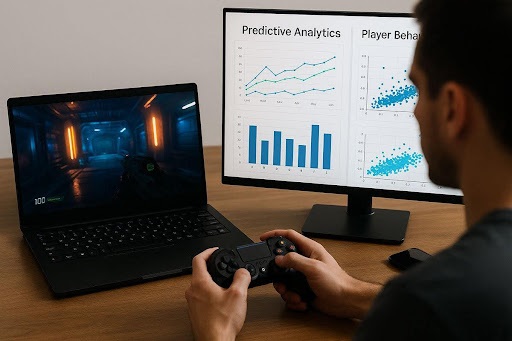The intersection of data science and gaming has opened fascinating windows into human behavior, decision-making and social interaction. As games increasingly shift to digital platforms, the wealth of player data provides unprecedented opportunities to understand not just how people play, but why they make specific choices in competitive and cooperative environments. This exploration of predictive analytics in gaming contexts reveals insights that extend well beyond entertainment into areas of psychology, economics and social dynamics.
Pattern Recognition in Decision Trees
Every game presents players with a series of decision points, creating unique pathways that, when analyzed collectively, reveal fascinating patterns about human problem-solving approaches. Experienced players often develop intuitive decision trees—mental frameworks for evaluating options based on probable outcomes—that analytics can now map with remarkable precision.
These visualized decision pathways highlight how expert players differ from novices, not just in knowledge but in their fundamental approach to evaluating situations. The most intriguing discovery is how these patterns often transfer between seemingly unrelated games, suggesting deeper cognitive frameworks at work.
When researchers track eye movements alongside decisions, they find that skilled players actually perceive different elements of the same game state than beginners do, literally “seeing” different strategic possibilities. These insights have practical applications beyond gaming, influencing everything from military simulation training to business strategy education, where understanding decision frameworks provides competitive advantages in complex, rapidly changing environments.
Social Dynamics Through Card Game Analytics
Traditional card games transitioning to digital platforms like rummy online have become unexpected treasure troves of behavioral data, revealing how social dynamics influence strategic choices. When players engage in rummy online, their betting patterns, timing decisions and risk tolerance generate data profiles that often contradict how these same individuals describe their own decision-making processes.
Fascinating research comparing in-person versus rummy online play shows that physical tells disappear but are replaced by equally revealing digital patterns—hesitation pauses, betting rhythms and chat interactions that sophisticated analytics can interpret.
The anonymity factor of rummy online platforms creates natural experiments where players, freed from social expectations, sometimes make dramatically different choices than their in-person counterparts. Gender differences in strategy emerge with statistical significance across large data samples, though individual variation always exceeds group tendencies.
Perhaps most interestingly, players who regularly participate in both physical and rummy online versions of the same game often develop distinct personas with measurably different risk profiles, suggesting contextual adaptation rather than fixed personal traits driving strategic behavior.
Predictive Modeling of Player Progression
The ability to forecast player development trajectories has revolutionized game design, enabling adaptive experiences that maintain the crucial balance between challenge and achievement. These progression models track subtle indicators—response times, strategy adjustments after failures, persistence through difficulty spikes to identify which players will likely become long-term community members versus those at risk of abandonment. The neurological reward patterns these models reveal show fascinating correlations between small, frequent achievements and sustained engagement, explaining why well-designed progression systems create such powerful motivation loops.
Individual learning curves display remarkable variation that defies simplistic categorization with some players showing explosive improvement after periods of apparent stagnation. When designers implement personalized challenge scaling based on these predictive models, player retention typically increases by 30-45% compared to fixed difficulty curves.
The emotional component emerges clearly in the data—players who experience periodic but unpredictable successes demonstrate substantially stronger engagement than those facing either consistent victories or failures. These insights have transformed educational game design, where personalized progression paths now adapt to individual learning styles rather than forcing conformity to standardized approaches.
Behavioral Economics in Virtual Economies
Virtual economies within games provide controlled environments for studying economic behavior without real-world consequences, yielding insights that challenge traditional economic theories. Player responses to artificial scarcity, currency inflation and market manipulation reveal fascinating departures from rational actor models, with emotional factors frequently overwhelming mathematical optimization.
When tracking resource allocation decisions across thousands of players, clear patterns emerge showing how perceived value often diverges dramatically from actual utility within game systems.
The willingness to exchange real currency for virtual goods provides particularly rich data about psychological value assignment that extends far beyond gaming contexts. These environments create perfect laboratories for testing economic policies before real-world implementation, as a demonstrated when one major game’s hyperinflation crisis precisely mirrored subsequent events in developing economies.
Trading behavior during unexpected game events reveals risk profiles that often contradict players’ self-reported attitudes toward uncertainty. Most interestingly research shows that virtual economic experience increasingly influences real-world financial decisions as younger generations transfer lessons between contexts, suggesting that game economies may function as a meaningful financial literacy training grounds.
Psychological Profiling Through Play Styles
The emerging field of ludopsychology uses play behavior to identify personality traits with accuracy that sometimes exceeds traditional assessment methods, revealing how games function as projective psychological spaces.
Different game genres attract distinct personality clusters with strategy games drawing systematizers while social simulation games appeal to empathizers, creating natural segmentation for research purposes. The choices players make when unconstrained by real-world consequences often reveal shadow aspects of personality rarely expressed in daily life, providing valuable insights for therapeutic applications.
Correlation studies between play styles and established personality inventories show surprisingly strong relationships between in-game risk tolerance and real-world decision-making approaches. Longitudinal analysis reveals that play patterns remain remarkably consistent across years and different games, suggesting fundamental behavioral signatures rather than contextual responses.
Perhaps most valuable for psychological research, games create environments where abstract concepts like cooperation tendency, authority response, and moral flexibility can be observed through concrete actions rather than self-reporting, eliminating significant social desirability bias. These insights have practical applications in team building, where compatible play styles often predict successful professional collaboration better than traditional compatibility metrics.
Predictive Health Applications Through Gaming Metrics
Emerging research suggests that subtle changes in play patterns may provide early warnings of cognitive and neurological changes, creating non-invasive screening tools for conditions ranging from depression to early dementia. Declining performance in games requiring specific cognitive skills processing speed, working memory, spatial reasoning, can identify domain-specific neurological issues before they become apparent in daily functioning.
The continuous nature of gaming data provides sensitivity to gradual changes that might be missed in periodic clinical assessments, creating ongoing monitoring possibilities without requiring dedicated testing sessions. Motion-based games generate particularly valuable data, as subtle changes in movement precision and reaction time correlate strongly with neurological health indicators. Sleep quality issues frequently manifest in changed play patterns during specific time periods before players recognize their own fatigue symptoms.
Perhaps most promising for preventative health, several studies have demonstrated that personalized brain training games designed around individual cognitive profiles show significant effectiveness in maintaining neural plasticity during aging.
The psychological benefits appear equally significant, with regular strategic game play associated with reduced anxiety symptoms and improved emotional regulation, particularly among adolescents navigating social developmental challenges.
Conclusion
The application of predictive analytics to gaming behavior represents more than an improvement in entertainment design—it offers unprecedented windows into human psychology, decision-making, and social dynamics. As games increasingly become sophisticated data-gathering systems, they provide natural laboratories for understanding human behavior without the artificial constraints of traditional research environments.
The insights gained from these analyses extend far beyond gaming contexts, offering valuable applications in education, healthcare, economics, and cross-cultural understanding. As this field continues to evolve, the boundaries between entertainment analytics and behavioral science will likely continue to blur, creating rich new territories for human understanding.







